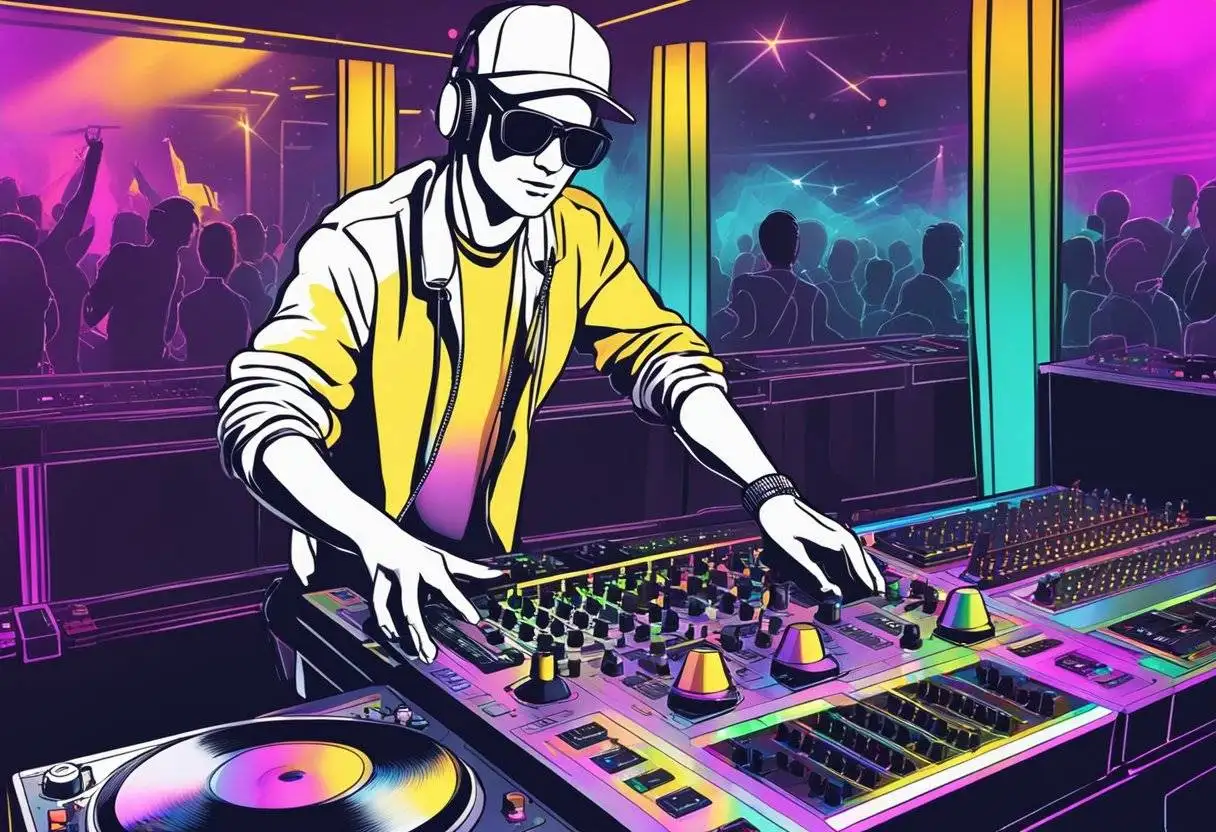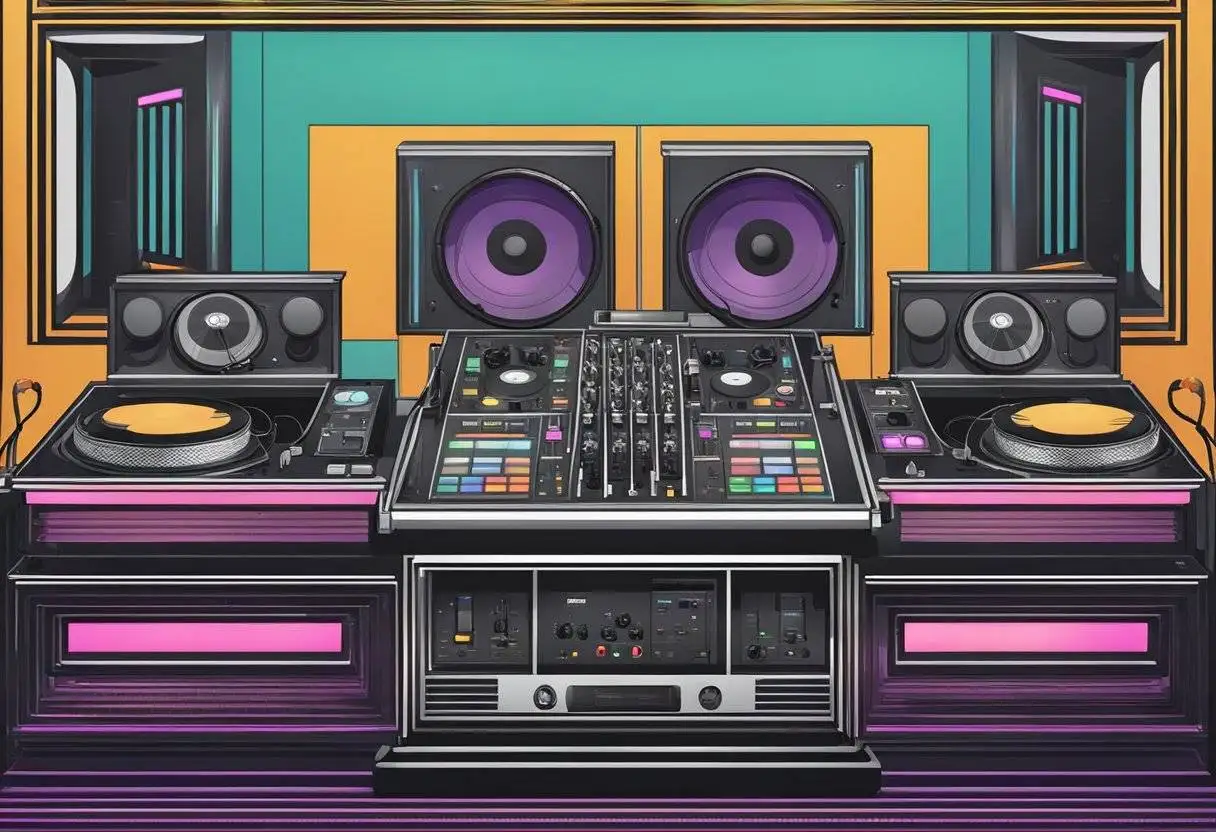Mixing music is an art form that has been refined over the years by DJs worldwide. My toolkit as a DJ is composed of various tools that enable me to blend tracks seamlessly, whether I’m setting the vibe in a cozy lounge or pumping up a crowded dance floor. At the core, my equipment typically includes turntables or CDJs, a mixer, headphones, and an array of sound effects. Staying adept with these tools allows me to keep the energy flowing and ensures that every transition is smooth and maintains the dance floor’s momentum.

As music and technology have progressed, my approach to DJing has also evolved. Digital tools and DJ software have become integral to crafting a set, offering a plethora of features that weren’t previously available. Programs like Traktor and Ableton give me precise control over the music with real-time manipulation of beats, bars, and phrases. Beatmatching by ear has always been a fundamental skill, but software can now assist with syncing tempos and matching keys, freeing me up to be more creative with my mixes. Understanding the venue and the audience is paramount, as it directs my choice of tracks and mixing style, ensuring that the music resonates and the crowd stays engaged.
Key Takeaways
- My DJ setup encompasses traditional turntables and mixers, supplemented by modern digital tools.
- Software assists with beatmatching, allowing more focus on creative elements of the mix.
- Tailoring my mix to suit the audience and venue is crucial for an engaging DJ performance.
Essential DJ Equipment
As a DJ, I understand that my performance hinges on reliable and high-quality equipment. My DJ setup is not just about mixing tracks; it’s about creating an immersive experience for the audience, requiring a fusion of various tools for seamless execution.
Mixing Hardware
The most vital components in my arsenal are the mixers, turntables, and DJ controllers. Mixers are the heartbeat of my setup, allowing me to blend audio from different sources with precision. Each channel comes equipped with level faders and a crossfader that give me control over the mix’s dynamics and transitions. My turntables are used for scratching and mixing vinyl records, bringing a classic touch to my sessions, while a modern DJ controller combines a mixer and players in one unit, interfacing with my computer to access and manipulate digital files.
Music and Sound Sources
My music library is a diverse mix of vinyl records and digital audio files. To access my digital collection, I use a computer equipped with DJ software that provides a digital vinyl system (DVS) experience. CDJs are a compact disc alternative to turntables, which are ideal for transitioning between analog and digital formats.
Audio Output Devices
For audio output, I count on high-quality speakers to deliver the sound and headphones for cueing tracks. An audio interface is critical, as it enhances the sound quality going out to the speakers and ensures my music is heard the way I intend it to be — clean, clear, and powerful. Whether I’m playing in a club or a private event, these output devices are crucial to making the night memorable.
(Links are incorporated based on instructions provided.)
DJ Software and Digital Tools
In today’s music scene, the right software is as crucial as a good ear for beats. DJs use a combination of digital tools and software solutions that enable them to mix, remix, and produce music efficiently.
Software Solutions for Mixing
When it comes to mixing, I’ve seen many professional DJs opt for Traktor, Serato, and Virtual DJ. Each of these offers a suite of features that cater to different aspects of DJing, such as beat matching, looping, and applying effects in real-time. Rekordbox is another popular choice, especially for DJs who prefer to prepare their sets beforehand and seek seamless integration with club-standard Pioneer DJ equipment.
- Traktor is lauded for its robust performance capabilities and customizable interface.
- Serato is widely recognized for its user-friendly design and reliability.
- Virtual DJ stands out with its video mixing feature and ability to stream songs directly from the internet.
- Rekordbox impresses with its ability to analyze and organize tracks, which simplifies the DJ’s job at the booth.
DJs typically run these software solutions on a laptop, which becomes the central hub of their setup. Integrated with a mixer or controller, this modern setup allows for high levels of improvisation and creative expression.
Learning and Mastering Software
Mastering the chosen DJ software is as important as selecting it. The complex functionalities and numerous features available in today’s DJ software require a significant investment of time and effort to learn.
DAWs (Digital Audio Workstations), such as Ableton and FL Studio, play a dual role. Not only do they serve as platforms for music production, but they also offer capabilities for DJs to create their own edits and tracks to bring to their performances. This knowledge of music production nuances enriches my ability to blend tracks seamlessly and innovate on the fly.
- Ableton is excellent for live performances due to its intuitive session view and powerful sample manipulation features.
- FL Studio is known for its pattern-based approach to music creation, making it a stalwart in electronic music production.
Through these tools, DJs like me unleash their creativity and tailor their performances to the audience, ensuring every set is unique and engaging.
Mixing Techniques and Fundamentals
In mixing music, the mastery of technical skills lays the foundation while creativity determines the uniqueness of a DJ mix. I’ll explore both essential components to give you insight into the disciplined and inventive nature of DJing.
Technical Skills in Mixing
Beatmatching: This is the skill of adjusting the tempo of two tracks to ensure they’re in sync. I use my ears and the pitch faders on my DJ controller to match the beats per minute (BPM), creating a seamless transition from one song to another. A well-executed beatmatch is imperative for a smooth DJ set.
EQing: To prevent sound frequencies from clashing, I apply equalization. EQing involves adjusting the low, mid, and high frequencies, thus ensuring that the mix delivers clear sound without muddiness. For example, when transitioning between two tracks, I might lower the bass on one track while introducing the bass of the next, maintaining a balanced sound spectrum.
Cueing: Pinpointing the exact moment to start the next track is critical in mixing. Utilizing headphones, I set cue points on my tracks to swiftly navigate to specific parts during a live performance, ensuring my timing is precise.
Creative Aspects of DJing
Transition Techniques: Beyond beatmatching, the art of the transition encompasses how I move between tracks. Whether it’s a smooth fade, a cut, or a more elaborate technique like a spinback, my approach depends on the mood I aim to set and the energy level I wish to maintain on the dance floor.
Effects Use: DJ mixers and software offer various effects that can add texture and excitement to a performance. Reverb, delay, and filters are among the tools at my disposal, each adding a different dimension to the mix.
Harmonic Mixing: To create a musically pleasing set, I consider the key of the tracks I’m playing. Harmonic mixing ensures that the songs not only match in tempo but sound harmonious when played together, greatly enhancing the listening experience.
Through precise control of tempo and sound with beatmatching, EQing, and cueing, I lay down a solid mix. My creative input through transition techniques, effects, and harmonic mixing brings vitality to the DJ set, engaging my audience with an unforgettable sound journey.
Understanding the Audience and Venue

As a DJ, I know that tailoring my performance to both the audience and the event space is crucial. I must consider the genre and mood of the music, ensuring it aligns with the expectations and energy of the crowd.
Adapting to Different Events
I recognize the importance of adapting my DJ sets for various venues, whether it’s a club DJ spinning at a pulsing nightclub or selecting tracks for a mellow event. Each venue carries its atmosphere and demographic, demanding unique approaches to the music I play. For instance, a nightclub typically expects energetic, danceable beats that resonate with the late-night crowd, whereas a radio event might require a more diverse playlist that caters to a broader audience. My knowledge and versatility must come into play here to deliver an appropriate set.
Track Selection and Playlist Curation
A carefully curated music library is indispensable to my role. I ensure a wide-ranging playlist, which allows me to dynamically respond to the mood of the audience. Track selection is not merely about playing what’s popular; it’s about weaving a coherent musical journey. For a club event, I may lean towards current hits in a specific genre that ensures the dancefloor stays full. In contrast, for a more subdued event, I might select slower tempo tracks that complement the ambience. Through my experience, I’ve honed the skill of adjusting track selection on-the-fly, which is essential for keeping the audience engaged.
Frequently Asked Questions

In this section, I’ve compiled a list of the most frequently asked questions regarding the tools and techniques DJs use to mix music. Whether you’re a beginner or simply looking to refine your skills, these insights will help guide your journey into the world of DJing.
What are the essential pieces of equipment for a beginner DJ?
For a beginner DJ, the essential pieces of equipment include turntables or CDJs, a mixer, headphones, and speakers. These components are the foundation for mixing tracks and performing live sets.
Which DJ software is recommended for those starting out?
For those starting out, I recommend DJ software like Serato DJ Lite or VirtualDJ, which are user-friendly and offer robust features for learning the basics of DJing.
Can you list some freely available DJ software for laptops?
Yes, some freely available DJ software for laptops includes Mixxx and UltraMixer Free, both of which provide a good starting point for beginners looking to practice without financial commitment.
How do DJs seamlessly blend one song into another?
DJs seamlessly blend one song into another by matching the tempo of the tracks and using a mixer to adjust the EQ levels and crossfade between the songs. Timing and a good ear for harmony are crucial for smooth transitions.
What are the popular DJ controllers among novices and professionals?
Popular DJ controllers among novices include the Pioneer DJ DDJ-200 and the Numark Mixtrack Pro 3, while professionals often gravitate towards higher-end models like the Pioneer DJ DDJ-1000 and the Denon DJ SC6000 Prime.
What are the steps to becoming a DJ using a laptop?
To become a DJ using a laptop, you’ll need to select suitable DJ software, familiarize yourself with the interface, practice mixing techniques, curate a library of music, and learn to analyse tracks for key and tempo. Understanding these fundamentals is key to creating engaging sets.
